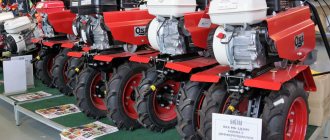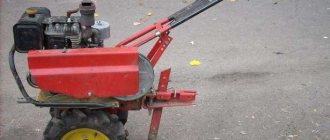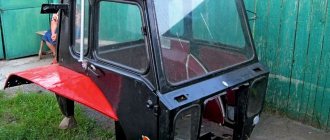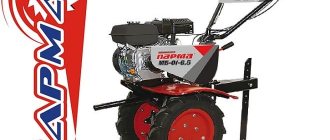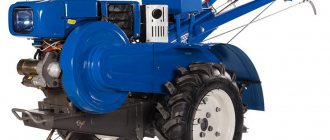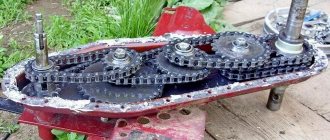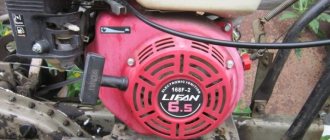Installation, repair, maintenance of OKA walk-behind tractor. User manual
This article will discuss the design, repair and maintenance of the OKA walk-behind tractor. Since 1991, this motorized device has been produced at the Kaluga Motor Plant under the name Motoblock MB-1.
Starting in 2011, the unit was renamed “Oka”. Its purpose is to carry out all types of agricultural work on small and medium-sized plots of land with different types of soil. Functional attachments, presented in the assortment by the manufacturer KaDvi, significantly expand the capabilities of the walk-behind tractor.
Motoblock Oka - operating instructions
When purchasing any Oka model, the first thing you need to do is read the operating instructions for the motorized device, which contains the following sections:
- The design of the unit (as well as the design of its components: gearbox, carburetor, etc.).
- Assembling the Oka walk-behind tractor, according to descriptions and diagrams.
- Technical characteristics of the selected model.
- Instructions for starting the engine for the first time (Lifan, Honda or any other).
- The procedure for proper running-in of the power plant.
- Maintenance.
- Troubleshooting the Oka walk-behind tractor.
Motoblock device
All existing Oka walk-behind tractors have the following device:
- Gas engine;
- rigid frame;
- adjustable steering bars with rubberized handles;
- transmission (reinforced chain reducer, V-belt transmission, mechanical gearbox, clutch, PTO drive);
- chassis (wheel drive);
- gas tank;
- filters (oil and air);
- ignition system;
- inertial starter.
The kit may include tillers and a hitch.
Depending on the modification, Oka walk-behind tractors can be equipped with various engines:
- The Oka MB-1D1(2, 3)M9 walk-behind tractor is equipped with a Honda carburetor engine (HONDA GX-200) with a capacity of 6.5 horsepower.
- Models MB-1D1 (2, 3)M10 have a Lifan gasoline power unit (Lifan168 F-2A) with a capacity of 6.5 liters. With.
- The MB-1D1 (2, 3) M15 walk-behind tractor was equipped with the original factory KADVI 168F-2A 6.5 liter engine. With.
- Modifications MB-1D1 (2, 3) M13 and M14 received a Robin Subaru EX17 or EX21 power plant, with a capacity of 6.0 and 7.0 liters. With. respectively.
- Models MB-1D1 (2, 3)M and MB-1D1 (2, 3)M1 are equipped with DM-1M and DM-1M1 engines with a power of 8 hp. With.
Honda GX200 engine Lifan168 F-2A engine Robin Subaru EX17 engine KADVI 168F-2A engine
Common to all listed power plants:
- one cylinder;
- cycle for 4 cycles;
- forced air cooling;
- use of AI-92 or AI-95 gasoline.
The ignition system is electronic, which includes: magneto, spark plugs, high-voltage wire.
It is necessary to start the engine correctly, according to the algorithm specified in the instructions. If certain actions are not followed, there is a high risk of engine failure. We invite you to watch a short video on how to start the Oka walk-behind tractor:
Gearbox device
The walk-behind gearbox transmits torque from the engine to the wheel drive. Its design is as follows:
- sprockets (driver and driven);
- chain;
- shaft:
- frame.
We suggest studying the cross-sectional diagram of the Oka walk-behind tractor gearbox:
The design and principle of operation of the carburetor
Carburetors are gas distribution devices inherent in gasoline engines. The function of the carburetor is as follows:
- regulates the amount of incoming gasoline and air;
- saturates the air with gasoline vapors.
We suggest that you familiarize yourself with the carburetor diagram for the Oka:
Run-in of Oka walk-behind tractor with Lifan engine
Before starting field work, it is necessary to break in the engine to avoid damage to moving parts and mechanisms.
Before starting the running-in, it is necessary to fill the tank with fuel and check the oil level. Proper running-in of the Oka walk-behind tractor engine begins immediately after the first start and lasts more than 30 hours. During this period, you cannot give heavy loads and work more than 2 hours a day, open the throttle valve more than ¾.
Tillage should also be carried out in a gentle manner - in several passes with a depth of no more than 10 cm in one pass. After the break-in period (20-30 hours worked in a gentle mode), it is necessary to completely drain the used oil and pour fresh oil into the engine crankcase.
Maintenance of Oka
Maintenance of a walk-behind tractor includes several stages:
- Daily work before and after use.
- Change of oil.
- Scheduled inspection.
- Preservation for long-term storage.
Let's consider the first point.
Malfunctions
The instructions included with the Oka walk-behind tractor contain a table that lists all possible problems, but we will focus on the most common ones:
Installing belts on the Oka walk-behind tractor
In order to perform the replacement, it is necessary to determine what size drive belt is required for the Oka walk-behind tractor. The following drive belts are available for sale:
Lighting for Oka walk-behind tractor
Many owners of this equipment strive to modernize the device as much as possible, to further increase comfort and ergonomics when working. One of the ways to modernize is to install lights (headlights).
Making light on an Oka walk-behind tractor is not that difficult; you just need to find and connect a generator of the required power to the unit. The connection algorithm is as follows:
- a button is placed on the steering wheel;
- the generator is attached to the walk-behind tractor;
- headlights are attached to the front of the motorized device;
- through wires, a connection is made from the button to the generator and to the headlight;
- wires are insulated.
The more powerful the generator, the brighter the light will be; many people prefer to install automobile electric generators on this agricultural equipment. We invite you to watch a video on how to install the light on the Oka walk-behind tractor yourself:
How to increase speed on an Oka walk-behind tractor
Maintenance of Oka
Maintenance of a walk-behind tractor includes several stages:
- Daily work before and after use.
- Change of oil.
- Scheduled inspection.
- Preservation for long-term storage.
Let's consider the first point.
Before operating the Oka walk-behind tractor, you must:
- check the oil and fuel levels; only fill in high-quality working fluids;
- check the reliability of bolted connections;
- check tire pressure.
After use you must:
- thoroughly clean and wash the walk-behind tractor;
- dry in the shade;
- lubricate all components and mechanisms;
- put into storage.
Motoblock Oka with plow
No less important is the second point - “Oil change”. The first replacement is made after running in the walk-behind tractor. After every 25 operating hours, the oil level in the gearbox is checked and fluid is added if necessary. The transmission oil is changed every 50 operating hours.
Routine inspections must be carried out after the first 100, 200 and 500 engine hours; it is recommended to completely change the oils, both in the engine crankcase, gearbox, and transmission.
It is recommended to fill the engine of the Oka walk-behind tractor with the following motor oils:
- M-53/10G1;
- M-63/12G1.
We invite you to watch a short video showing how to change the oil in the gearbox of an Oka walk-behind tractor:
Malfunctions
The instructions included with the Oka walk-behind tractor contain a table that lists all possible problems, but we will focus on the most common ones:
Why the Oka walk-behind tractor does not start:
- the tank has run out of fuel;
- the oil level in the crankcase is below normal;
- the ignition system of the Oka walk-behind tractor requires adjustment or has failed;
- carburetor adjustment required;
- filters are clogged and require replacement;
- spark plugs are burnt out, smoked or wet;
- the seals have failed.
The wheels (cutters) have stopped rotating:
- the clutch cable is loose;
- it is necessary to change stretched or torn belts, this will help restore the functionality of the Oka walk-behind tractor.
The gearbox is leaking:
- the cause may be worn out cuffs of the axle shafts; they need to be replaced with new ones;
- The seals require replacement.
Replacing the oil seal
Before changing the oil seal on the gearbox of the Oka walk-behind tractor, you need to pay attention to the manufacturer, since each part has its own technical parameters, and the replacement procedure will differ significantly.
The oil seal is one of the simplest components of a walk-behind tractor. The cost of such a device is also low. It’s easy to determine that replacement is necessary; you just need to observe the condition of the oil, namely whether it is leaking. If this is not done, then the cost of repairs will increase.
You can replace the oil seal yourself
If you decide to make the replacement yourself, then the question arises: “How to change the oil seal on the gearbox?” The first thing to do is prepare the work surface and adjust the lighting. Next, follow these steps:
- Drain the oil from the device.
- Prepare a piece of cloth to wipe all components.
- Remove the wheels.
- Remove the boot and oil seal. This can be done with a slotted screwdriver. The part needs to be pryed and simply pulled out with a rag. Such parts are not repaired, but replaced.
- Next, wipe the shaft with a cloth, but first you need to oil it.
- Then fill the oil back.
- Put on the wheels.
Important! Remove the wheel from which you want to replace.
Adjusting the straps
Adjusting the belt tension of OKA walk-behind tractors, as well as installing belts on a walk-behind tractor, does not require excessive physical effort or technical equipment.
Important! If, when you press the belt drive with your hand, it only goes down a little, then everything is fine with it.
Excessive sagging can lead to such negative consequences as:
- unwanted vibration of the unit;
- problems with the motor due to lack of necessary traction;
- smoke formation.
Adjustment of spare parts for the belt drive of the OKA walk-behind tractor is carried out as follows:
- free the walk-behind tractor frame with the motor part from the nuts using a universal wrench;
- tighten the adjusting bolt and at the same time control the degree of belt tension. It is necessary to achieve such an effect when they spring back, easily returning to their original position. Do not overdo it with tension, as this can damage the bearing;
- It is important to pay attention to the position of the motor. If shifts or distortions are observed, unscrew the adjusting screw and fix the nut on the back of the unit body.
It would be appropriate to carry out a similar check for new spare parts of the belt drive for more accurate adjustment and tension.
If you properly monitor the condition of the motor cultivator and promptly replace spare parts that have become unusable, the equipment will last for more than one season.
Gearbox malfunctions
There are many reasons that can lead to the breakdown of this important unit, which will make the operation of walk-behind tractors from different manufacturers impossible. It is advisable to include among the main malfunctions characteristic of various models:
- oil leak due to high wear of the cuff;
- inappropriate lubrication parameters;
- the appearance of smudges on the output shaft;
- star rupture;
- broken chain/belt;
- Worn control lever threads.
It is important to note that most problems can be avoided by promptly changing the oil in the device. For this purpose, standard machine oil is used, which allows you to use the walk-behind tractor for many years without the need for repairs.
Do-it-yourself gearbox repair
The need to repair a twin-shaft gear reducer may arise for various reasons. The procedure for troubleshooting most faults is extremely simple and does not require any special knowledge or skills. In most cases, product repairs follow the standard algorithm:
- The oil is drained and the unit is subsequently cleaned of contaminants.
- A cast iron or other type of converter is disassembled, each part is inspected for damage, defects, and excessive wear.
- If problematic elements are found, they will need to be replaced with new ones.
- The device is assembled, the oil is changed.
There are several typical problems that occur most often among this type of technology. First of all, this is a failure in the clutch sliding, which can be eliminated by replacing the spring and discs. If the device begins to make significant noise during operation, an immediate replacement of the oil and gear mechanism is most likely required.
How to change the oil in a mechanism
One of the most important factors influencing the service life of various types of gearboxes is the presence of oil. It needs to be changed regularly, which will avoid most problems. To do this, follow the simplest instructions:
- Place the gearbox in working position at a slight inclination.
- Check the oil level. Normal indicators are 25-30 cm of the probe.
- Place the walk-behind tractor on a raised platform, then unscrew the plug on the housing.
- Wait until the oil is completely drained into the container, then fill in new oil using the appropriate hole.
Products from most well-known manufacturers are suitable for use, as well as any other oil that complies with GOST-17479.
How to change the oil seal
Owners of walk-behind tractors often have to deal with oil seal failure - a simple malfunction that can be quickly fixed. To do this you will need to perform a number of simple manipulations:
- Remove the cutters from the shaft and clean them of dirt.
- Remove the cover by unscrewing the corresponding bolts.
- Install a new oil seal.
Timely completion of such a procedure is extremely important for the correct operation of the unit, since a malfunction of the oil seal leads to intense oil leakage, which can lead to more serious problems.
Instructions for using the device
Replacing consumables (oil, fuel) Engine oil changes in the MB-1D1M10 must be performed according to the manufacturer’s instructions: the first after start-up - after 5 hours, then - at intervals of 25 hours.
Recommended oil:
| Volume | Oil type | |
| Crankcase | 1,3 | Automotive motor oil for carburetor engines M-53/10G1 or M-63/12G1, or any oil that meets the requirements of API: SF, SG, SH and SAE: 10W-30, 15W-30 |
| Walk-behind tractor gearbox | 1,8 | Transmission oil TAD-17I, TAP-15V, etc. GOST 23652-79 or other, in accordance with SAE: 80...85W API: GL3...GL4. |
The transmission oil should be changed every 100 operating hours.
The factory instructions for the walk-behind tractor prescribe the use of oil TAD-17I, TAP-15V and others in accordance with GOST 23652-79; it is also allowed to combine oils in any proportion.
Recommended fuel: high-quality gasoline AI92.
Before starting work with the walk-behind tractor, make sure that all components are securely fastened. Do not shift from forward to reverse with the engine running! This may cause damage. To safely shift from forward to reverse, stop the engine, shift the shift lever to the desired position, and then start the engine again.
Daily Maintenance
- Remove dust, dirt, and oil from the external surfaces of the engine.
- Inspect the connection of the cylinder head to the engine cylinder block; if necessary, tighten the cylinder head bolts on a cooled engine in a diametrically opposite manner crosswise through 3 bolts.
- Check the reliability of the engine mounting and, if necessary, tighten loose connections.
- Check the tightness of the gas line hose connections from the fuel tank to the carburetor.
- Clean the protective casing (inlet to the fan) from foreign objects.
Technical inspection after 25 hours of operation: check the tightness of the gas hoses, add oil, and after 50, check the degree of tension of the V-belt drive belts, replace the transmission oil.
The Oka MB-1D1M10 walk-behind tractor is designed to operate at temperatures down to -50C. In winter, the following manipulations will help make starting easier: before work, the walk-behind tractor must be in a warm room for at least 10 hours. You can pour oil heated to 50-60 degrees into the engine. After adding hot oil, allow the engine parts to warm up for 10-15 minutes.
If the engine does not start, you should warm up the carburetor pipe and the carburetor itself by placing a cloth moistened with hot water on them.
Replacing forward and reverse belts
Replacing the OKA walk-behind tractor belt is carried out without the use of technical devices by releasing the clamping mechanism, so you can carry out this action yourself, without the involvement of technical specialists. The main thing is care and accuracy when working. An important nuance is the use of drive mechanism parts with identical parameters.
The belt installation diagram is as follows:
- First you need to remove the reverse belt. Loosen the drive pulley bolt and pull the spare part away from the lever.
- We unscrew the two bolts from the bracket, remove the limiting pins and remove the forward belt.
- We put new belts in place of the old ones in accordance with the direction of the forward pulley and the reverse pulley, and then tighten the bolt of the drive pulley and bracket.
- To assess the correct placement of the belts on the walk-behind tractor, you must release the clutch lever. If they sag in this position, it means that all of the above steps were completed successfully. Otherwise, it is necessary to adjust the position of the belt drive until it is in the correct position.
MB-1 cultivator gearbox design
Let's look at the design of the gearbox of the MB-1 walk-behind tractor. This is a device responsible for rotation, movement from the engine to the wheels. The MB-1 walk-behind tractor gearbox is assembled in such a way that on its outer side there are elements responsible for changing gears. The gearbox has five positions. When pressed, the fork disengages the clutch. When reset, it returns to its original position.
When the drive is connected to the right side, the unit will stop. The rotation comes from the sprocket. When the handle catches the left sprocket, the gear is reduced. If maximum gear is desired, the handle is pulled out all the way.
Assembly and adjustment of the gearbox is carried out after repair or malfunction. Before the procedure, each part is inspected for damage and contamination.
Sometimes the engine on the MB-1 walk-behind tractor is replaced. This is done if you want to install an imported engine on a domestic model. For this purpose, a kit is used, which includes a plate (platform, pulley), belt transmission, and a set of fasteners. There is an engine replacement diagram. Thanks to the drawings, it will be possible to easily cope with the replacement.
Old-style motor cultivators are also popular. The first Soviet walk-behind tractor, MB-1, is a very durable and reliable technique that was used for various purposes. They were produced on the basis of Soviet cultivators, which were quite durable.
Types of gearboxes
According to their purpose, gearboxes are divided into the following types:
- Geared. The gear in them is in the form of a cylinder and a cone, and it is mounted on special shafts. According to its design, such a gearbox can operate in a straight line or in an angular pattern;
- Gear-worm. They are used when the engine crankshaft is vertical. This model includes a worm gear. Turns are performed at an angle of 90 degrees;
- Chain. A metal chain is used, which turns the sprockets;
- Belt. This is an analogue of the chain type, but here instead of a chain a belt in the shape of a wedge or rectangle is used, and sprockets are replaced by pulleys with profile grooves for fixing the belt.
Reviews
Andrey, Omsk:
“In the spring, we work with a plow on the Oka River, which is already 4 years old. Before that I only used cutters and didn’t do much plowing. The first time I walked around the site - the mini tractor pulls the plow well, the soil is loose. After the second pass, I really liked the quality of the soil - I didn’t even need a rake. I don’t recommend repeating my mistake - don’t use a plow where turf grows. The blade will not cut small branches, and the straps may break, as happened to me. Otherwise, I recommend using a plow, it makes the work much easier!”
Valentin, Kazan:
“Of course, I had to get used to working with the plow. Firstly, plowing turned out to be the hardest type of work, which is why I would not use a plow for a cultivator at all. But if the tractor is heavy, then it’s fine. “Oka” has enough weight, and sometimes it goes hard. I advise you to add additional load to the wheels, then the center of gravity will drop lower and the load on the axle bearings will decrease.”
Dmitry, Tula:
“Maybe someone will find my experience of working with a plow on the Oka useful. I always make adjustments so that the ploughshare and plow heel are in contact with the ground, while the stand should be in a vertical position. Then I go through the first rows, again adjust the stand to full vertical, and change the amount of recess into the ground with the screw on the hitch. IMPORTANT: the rear edge of the share is placed at the same level with the lug, with its internal dimension, when we pass the third and subsequent furrows!
Owner reviews
Alexei. An excellent walk-behind tractor for people who know how to handle basic equipment. I have been using Oka for more than 4 years and have no complaints. The walk-behind tractor is reliable, the quality of the metal allows it to be used in harsh conditions.
Ignatius. Based on my experience, MB Oka turns out to be an indispensable assistant when cultivating medium and small plots of land. I bought mine 10 years ago. Then, on the advice of the seller, I bought the entire set of attachments. Among the advantages, I can highlight excellent maneuverability, reliability and the ability to self-repair.
Vyacheslav. I've had my MB Oka for six years now. I don't use it in winter, but from spring to late autumn I work on it 8 hours a day. With its acquisition, my work has become much easier, because with its help I dig, plant and even harvest. I advise everyone to purchase this reliable domestic walk-behind tractor.
Specifications
Parameter Parameter value
| Gearbox type | Chain |
| Overall dimensions, mm., no more | 1500x600x1050 |
| Operating weight, kg., no more | 90 |
| Ground clearance, mm. | 140 |
| Transport gauge, adjustable, mm. | 310, 590 |
| Traction force, kgf., not less | 100 |
| Travel speed | 1st gear - 3.6 km/h 2nd gear - 9 km/h |
Do-it-yourself walk-behind tractor trailer
A trailer for a walk-behind tractor is a necessary thing, and sometimes even necessary in a private household. In this material we will look at how to make a trailer for a walk-behind tractor with your own hands, focusing on the drawings and descriptions for them.
In the diagram below, a homemade trailer for a walk-behind tractor, capable of transporting a load weighing more than 400 kg, but first things first. The trailer is equipped with a driver's seat, it is unpretentious in operation and quite simple to manufacture.
Walk-behind tractor "OKA". Replacement of belts and adjustment. At the request of viewers.
509
February 19, 2019
Alexander Skopinsky
I gleaned very useful information from this video, in the spring I’ll work on adjusting the reverse gear, re-drilling the hole, creating a larger lever, otherwise every time I pull the walk-behind tractor backwards on myself when I need to turn around.
Rustem Stryukov
That's it, I found it. The maximum tire pressure is 2.8 atmospheres. Thank you.
